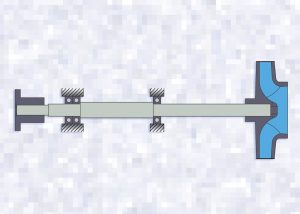The terminology of a technical subject is key to understanding it. The language of modern pump technology has evolved for well over a hundred years. During this period, meanings of terms have changed. Good definitions are sometimes difficult to find.
In nearly four decades of experience I’ve located key terms and their useful meanings. In this article I provide explanations for a selection of centrifugal pump terms that I feel would benefit from clarification. I’m limiting this article to descriptive concepts rather than mathematical, since the narrative is sometimes incomplete, confusing or all but omitted in technical literature.
Affinity Laws / Affinity Rules
The Affinity Laws are not actually physical laws. So recently pump engineers started switching to the term ‘Affinity Rules.’ But because the term ‘Affinity Laws’ is so securely embedded in decades of pump literature, there’s no point in making a big fuss over this. I’m of the opinion they should be called Affinity Rules, so that’s what I’m going to call them.
Affinity Rules express, in algebraic relationships, the variation in flow, head and power resulting from a change in pump speed or a change of impeller diameter. In the case of a change of impeller diameter, the Affinity Rules are an approximation and actual test experience with a given design of pump is important.
To understand the effects of changing speed or impeller diameter on a given pumping system it is necessary to plot the pump head-versus-flow performance curve on top of the system head-versus-flow curve.
Centrifugal pump
‘Centrifugal pump’ is the most common type of industrial pump. It is a pump equipped with a vaned impeller that, as it rotates, draws in liquid to its center, the eye, and discharges flow peripherally outward in a radial direction. A centrifugal pump may have a ‘double suction’ or ‘double entry’ impeller type which can be visualized as two impellers positioned back-to-back. A centrifugal pump may consist of one or more stages of impeller-plus-volute-or-diffuser.
Deep-well pump
A ‘deep-well pump’ is also known as ‘turbine well pump.’ It is the same pump type as a ‘vertical turbine pump’ or a ‘turbine pump’ and is used for water well applications.
End-suction pump
‘End-suction’ refers to a single-stage pump arrangement where the suction nozzle leads directly into the eye of the impeller that is attached to the end of the pump shaft.
Head
‘Head’ is often used as an abbreviation for ‘Total Head’ or ‘Total Dynamic Head’ (see definition).
Each element of a pumping system could be evaluated based on its contribution to, or reduction of ‘head.’
Net Positive Suction Head
It may be easier to think of Net Positive Suction Head (NPSH) in terms of pressure. NPSH is a measure of how much pressure is keeping the liquid from boiling or flashing into vapor. For a liquid to remain in a liquid state, the value of NPSH must be at least slightly higher than zero. At the point where a pot of water is boiling, NPSH is zero.
Related terms are Net Positive Suction Head Required (NPSHr) which is how much is needed by the pump to operate, and Net Positive Suction Head Available (NPSHa) which is how much is provided by the system.
The term ‘NPSH’ without the ending modifier ‘Required’ or ‘Available’ often refers to either NPSHr or NPSHa and the reader is left to determine from context which it is.
Overall efficiency
‘Overall efficiency’ is the pump hydraulic power output divided by the driver power input.
When determining ‘overall efficiency,’ it is advisable to carefully identify the boundaries of the included equipment and any ancillary equipment required – such as a pressurized lubrication system or a mechanical seal support system. And what about motor controls, power cabling, the connected piping, fittings or, say, a suction barrel? For purposes of defining ‘total head,’ where are the pressure measurements taken? Does the pump flow measurement include or exclude flows required for cooling or seal flush, or leakage flow from a thrust balancing device? All such items should be clearly spelled out if a minimum ‘overall efficiency’ is a specified performance guarantee.
Overhung pump
An ‘overhung pump’ refers to the broad classification of pumps where the impeller is attached to the end of the pump shaft, cantilevered from its bearings. ‘End-suction’ pumps are included within the ‘overhung pump’ classification.
Rotodynamic pump
The term ‘rotodynamic’ refers to the broad class of pumps that create pressure by means of a rotating impeller, propeller or disc which adds velocity to the fluid. The term ‘rotodynamic’ encompasses centrifugal pump, mixed flow pump, axial flow pump and disc pump types. The term ‘rotodynamic’ is a relatively new classification term in the field of pumps and is gradually making its way into published literature and standards.
Specific Speed
‘Specific speed’ is the key performance parameter of a rotodynamic pump. It is defined by an equation with the variables of speed, flow and head. A particular published value of specific speed is often not a purely dimensionless number, but rather depends upon the customary set of units used.
Specific speed, sometimes referred to as a ‘type number,’ is often associated with the approximate shape of the impeller. The specific speed parameter is of great importance to the world of pump hydraulic experts. It is mostly of incidental significance to the specifiers and users of pumps.
Suction recirculation
There are two possible definitions for suction recirculation.
The more common usage is in connection with the complex ‘flow reversal’ pattern that occurs at the eye of an impeller. This is similar to the action visible in a food blender where at the rotating blades the mixture is forced outward and upward and is then drawn back down into the vortex, and back to the blades. In a pump impeller a similar action occurs at reduced flow. The induced vortexing and swirling travels upstream from the eye of the impeller and is normally accompanied by a violent turbulence and clouds of bubbles.
This might be a useful mode of operation if the pump is being used as a mixer. But otherwise, it is wasteful of energy, causes elevated levels of vibration, increased levels of cavitation and can generally accelerate wear of the pump.
Another type of suction recirculation involves leakage flow from the higher pressure discharge region in the pump back to the impeller suction. This leakage takes place across wear rings which are located at the impeller eye (inlet) shroud. On some pumps there are impeller back (hub) shroud wear rings with passages (usually holes) communicating through to the eye inlet region. The term ‘suction recirculation’ might also be applied to the returning flows from sealing devices, throttle bushings, etc.
Total dynamic head (TDH) is a measure of energy the pump adds to the liquid. It is also the system resistance that the pump must overcome. TDH is expressed as an equivalent height in feet or meters. Its value includes the effects of pressure, velocity, elevation and flow resistance.
Instead of pressure differential, TDH is often more useful for pumps because it is independent of density. Therefore pump performance values for head versus flow on differing liquids can be easily compared with the baseline performance on water. The value of TDH can always be converted to pressure if the density or specific gravity of the pumped liquid is known.
Total head
Same as ‘Total dynamic head.’
Vertical can pump
The term ‘vertical can pump’ is sometimes called a ‘barrel pump’ or ‘canned pump’ and is not to be confused with ‘canned motor pump.’ The ‘can’ is the ‘suction barrel’ or ‘suction receiver’ which fully encloses the intake of this type of vertical pump. Often, the primary purpose of the can is to add static liquid height at the pump’s suction impeller intake located near the bottom, and thus increase the Net Positive Suction Head Available. A vertical can pump arrangement is sometimes selected due to its relatively compact footprint compared with that of a horizontal pump and driver arrangement.
The term ‘vertical turbine pump’ (VTP), also known as ‘turbine pump,’ applies generally to vertical diffuser bowl (casing) type pumps used in water wells and other industries. The term ‘turbine pump’ was evidently derived from a patent taken out in 1875 by renowned engineer Osborne Reynolds describing an arrangement of rotating and stationary vaned passages that can be used as a turbine or as a centrifugal pump.
Volute
First of all, a note on pronunciation. The author and most everyone he speaks with about pumps pronounces it vuh-loot′ – it rhymes with ‘salute.’ The alternate pronunciation vall′-yoot sounds somewhat like the word ‘volume’ with a heavy stress on the first syllable. The author suggests you use the alternate pronunciation only if you believe you are worthy.
The term ‘volute’ refers to the enclosing pump casing’s internal passageway which is shaped like the expanding spiral of a snail. The volute collects flow from the impeller, diffuses kinetic energy into pressure and guides the flow to the pump discharge nozzle. Many pump volutes are designed with two diffusing passageways and this arrangement is known as a ‘double volute.’
The above pump terms and many others are found in industry standards, handbooks, texts, and online literature. But these are perhaps the most frequently misunderstood or inadequately defined terms in the jargon of pumps. The author has singled these out to provide easy‑to‑grasp concepts that might be especially helpful to someone new to the field.
For an independent evaluation of the design and specifications for pumps and pumping systems, contact an experienced consulting engineer who can help with your specific application.






